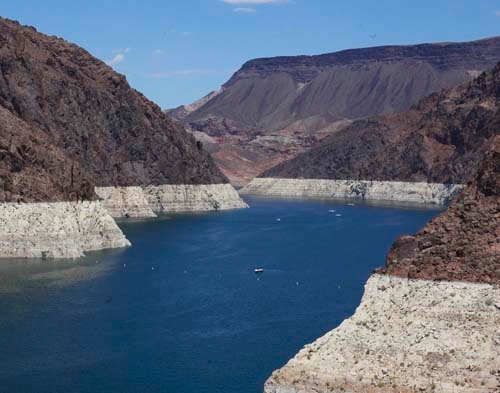Water outlook grows dim for Colorado River watershed
One terrible month in the mountains that feed the Colorado River has erased almost 600 billion gallons from an already bleak outlook for Southern Nevada's primary water source.
Federal forecasters have slashed their projections for the river after an unusually warm, dry March sent mountain snow into full retreat.
"Snowpacks were falling faster than a 3-year-old in high heels" last month, said Randy Julander, who supervises the federal snow survey program in Nevada, Utah and California. "They were tumbling left and right."
Julander said much of the range already looks like it usually does at the end of May. In places where snow should still be accumulating, there is barren ground and the threat of wildfires.
"March was simply not kind to us," he said.
And this late in the season, there is little hope of improvement.
"When you put snow on warm, bare land, it just melts. It doesn't accumulate," Julander said.
Even before March, forecasters were predicting a below-average year on the Colorado. Now they expect this to be the second-driest year the river has seen since drought descended on the region in 2000.
But there is a silver lining, according to Rose Davis, spokeswoman for the U.S. Bureau of Reclamation's lower Colorado River regional office in Boulder City. Last year was so wet that Lake Mead won't feel much immediate impact from this year's sorry snowpack.
"We don't have an emergency," Davis said. "It's disappointing, but it's not devastating."
The Las Vegas Valley draws 90 percent of its water from the Colorado River by way of Lake Mead.
The surface of the reservoir is now expected to drop about 17 feet over the next year, according to a Bureau of Reclamation forecast released Tuesday. That's not much worse than last month's forecast, which predicted a 15-foot drop in Mead by next April.
Most of the water in the Colorado River begins as snowfall in the mountains of Utah, Colorado and Wyoming.
Those areas were buried under record or near-record amounts of snow in late 2010 and early 2011.
The resulting deluge of snowmelt pushed Lake Powell, on the Utah-Arizona border, to its highest level in a decade and added more than 50 feet to Lake Mead, returning the nation's largest man-made reservoir to where it was in the spring of 2006.
The amount of water in Lake Powell determines how much water Lake Mead receives in a given year.
Until last year's boost, Mead was one dry winter away from an unprecedented federal shortage declaration that would have forced Nevada and Arizona to reduce the amount of water they draw from the river.
Such a shortage declaration also would trigger a final vote by the Southern Nevada Water Authority board over whether to start construction of an expensive and controversial pipeline network to tap groundwater across rural eastern Nevada.
According to the National Oceanic and Atmospheric Administration, last month ranked as the warmest March in the lower 48 states since people started keeping track of such things in 1895.
In Colorado, it was the driest March on record.
"Now all we need is a dust storm and a plague of locusts and we'll be all set," joked J.C. Davis, spokesman for the water authority.
He said the sudden change in fortune on the Colorado reinforces the importance of current and future projects aimed at securing the community's water supply.
As conditions at Lake Mead improved over the past year, some questioned why the authority is spending $800 million to build a new intake pipe to draw water from the deepest part of the reservoir. But with the lake now "riding the string back down the yo-yo," J.C Davis said, that project looks as important as ever.
So does the proposed pipeline to rural Nevada, which authority officials call a water-supply safety net but critics have labeled as a needless and destructive waste of money.
The multibillion-dollar project is still undergoing a federal environmental review and faces a host of legal challenges. Then the authority will have to find some way to pay for it.
J.C. Davis said the bleak outlook for the Colorado River all but guarantees that Lake Mead won't be getting any extra water from Lake Powell for at least the next two years.
And because farms and cities from Wyoming to Mexico are entitled to take more water than the famously fickle Colorado actually provides, Lake Mead will continue shrink toward shortage without more extremely wet winters like the one that filled the river to overflowing just one year ago.
As reclamation's Rose Davis put it, "We need to do some more snow dances."
Contact reporter Henry Brean at hbrean@reviewjournal.com or 702-383-0350.


















